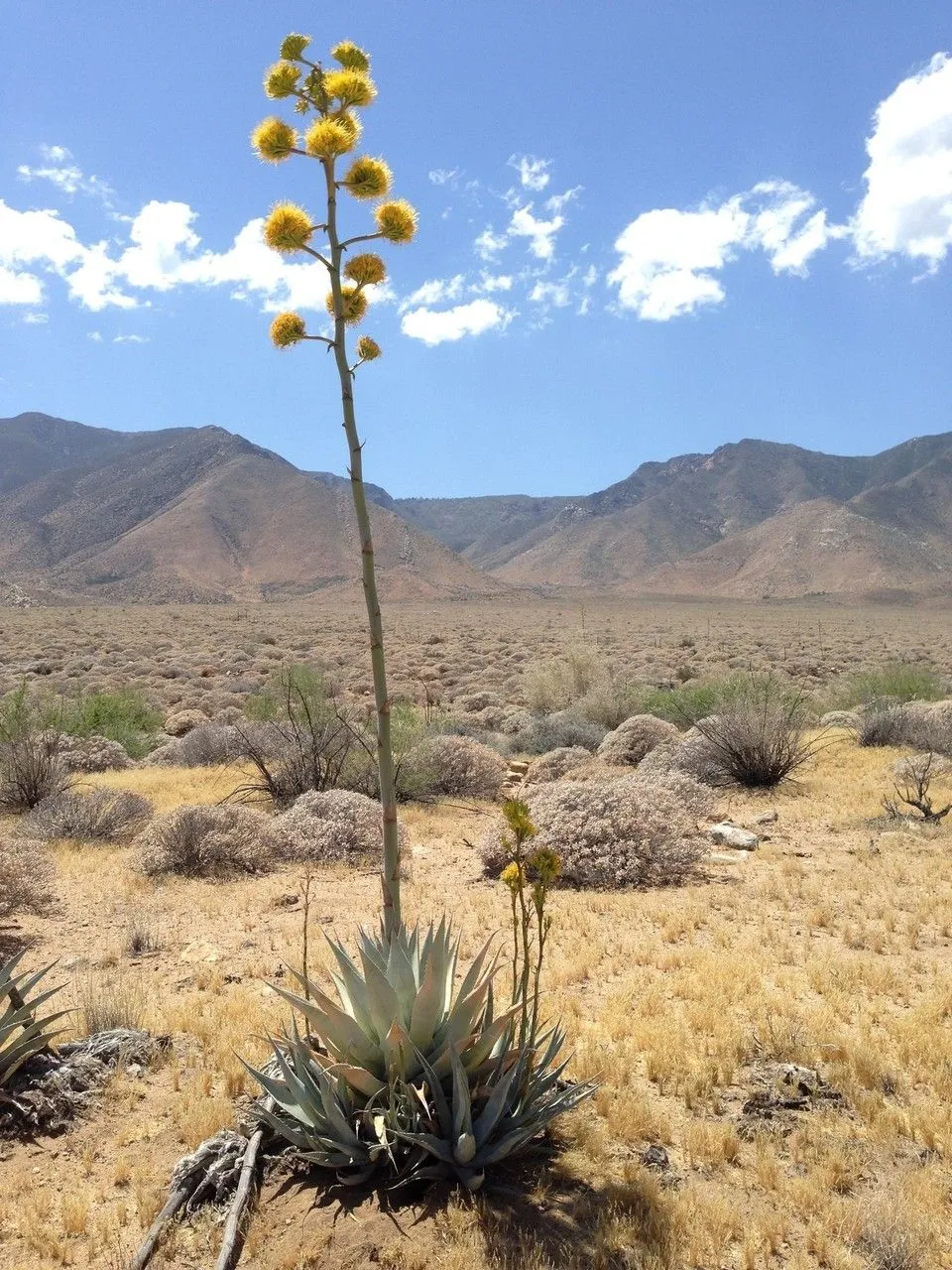
Author: Engelm.
Bibliography: Trans. Acad. Sci. St. Louis 3: 310 (1875)
Year: 1875
Status: accepted
Rank: species
Genus: Agave
Vegetable: False
Observations: S. California to Mexico (N. Baja California)
The Desert agave, scientifically known as Agave deserti, is a remarkable plant native to the arid landscapes stretching from Southern California to Northern Baja California in Mexico. First documented in the academic literature by George Engelmann in 1875 within the Transactions of the Academy of Science of St. Louis, this hardy succulent belongs to the family Asparagaceae.
Agave deserti is uniquely adapted to survive in some of the harshest environments on the planet, making it an icon of desert ecology. Its rosette of thick, fleshy leaves serves as a water reservoir, enabling the plant to thrive through prolonged periods of drought. The leaves themselves are a stunning silver-blue color and are bordered by sharp spines, offering a natural defense against herbivores.
The lifecycle of the Desert agave is also quite remarkable. It is a monocarpic plant, meaning it flowers only once before dying. This event, known as the “century bloom,” although it occurs roughly every 10 to 30 years rather than a century, features a towering flower stalk that can reach heights of up to 15 feet. The stalk is adorned with clusters of yellow flowers that attract a variety of pollinators, including bats and insects, vital for the plant’s reproductive success.
After the flowering phase, the main plant withers and dies, but not before producing a number of offsets, or “pups,” at its base. These pups continue the life cycle of the agave, ensuring the spread of this resilient species across its native range.
The Desert agave holds additional significance beyond its ecological role. Indigenous peoples have long utilized various parts of the plant for food, fiber, and tools, illustrating the agave’s importance in cultural heritage and traditional knowledge. The heart of the plant, rich in carbohydrates, was historically cooked and consumed, while the fibrous leaves were processed into ropes and textiles.
In modern times, the Desert agave is not just valued for its utilitarian uses but also appreciated for its ornamental properties. It is widely cultivated in xeriscaping and rock garden designs, prized for its striking appearance and low water requirements.
Overall, Agave deserti exemplifies the extraordinary adaptability and resilience of desert flora, making it a subject of both scientific interest and cultural reverence.
Spa: maguey de desierto
Eng: desert agave
En: Desert agave, Century Plant or Maguey, Mescal
Ar: أغاف صحراوي
Es: Maguey de Desierto
© copyright of the Board of Trustees of the Royal Botanic Gardens, Kew.
Taken Aug 1, 2020 by EMANUELE ISNARDI (cc-by-sa)
Taken Aug 4, 2021 by Steph Gatewood (cc-by-sa)
Taken Aug 21, 2021 by Stephane piatzszek (cc-by-sa)
Taken May 15, 2021 by sarah simms (cc-by-sa)
Taken Aug 11, 2019 by Ranjana Patil (cc-by-sa)
Taken Feb 24, 1999 by EOL − J. E.(Jed) and Bonnie McClellan (cc-by-nc-sa)
Taken Feb 18, 2001 by EOL − Robert Potts (cc-by-nc-sa)
Taken Jan 20, 2014 by EOL − William Flaxington (cc-by-nc)
Taken May 6, 2014 by EOL − Gerald and Buff Corsi (cc-by-nc-sa)
Taken Jun 9, 2015 by EOL − James Mickley (cc-by-nc)
Taken Feb 27, 2022 by Martin Bishop (cc-by-sa)
Taken Oct 31, 2020 by Martín Lago (cc-by-sa)
Taken Feb 18, 2001 by EOL − Robert Potts (cc-by-nc-sa)
Taken Jun 1, 2022 by Mary Kingfishers (cc-by-sa)
Taken Jan 1, 1900 by EOL − Stan Shebs (cc-by-sa)
Taken Dec 2, 1998 by EOL − Charles Webber (cc-by-nc-sa)
Taken Apr 4, 2021 by César Pérez Arroyo (cc-by-sa)
Taken Apr 4, 2021 by César Pérez Arroyo (cc-by-sa)
Taken Jul 12, 2011 by EOL − Gerald and Buff Corsi (cc-by-nc-sa)
Taken May 14, 2019 by Angie Angie Mims (cc-by-sa)
Taken Apr 9, 2018 by Alban THIBAULT (cc-by-sa)
Taken Jul 27, 2019 by andersson caroline (cc-by-sa)
Taken May 13, 2005 by EOL − Richard Zmasek (cc-by-nc-sa)
Growth habit>: Subshrub, Shrub, Forb/herb
Family: Myrtaceae Author: (F.Muell.) K.D.Hill & L.A.S.Johnson Bibliography: Telopea 6: 402 (1995) Year: 1995 Status:…
Family: Rubiaceae Author: Pierre ex A.Froehner Bibliography: Notizbl. Bot. Gart. Berlin-Dahlem 1: 237 (1897) Year:…
Family: Sapindaceae Author: Koidz. Bibliography: J. Coll. Sci. Imp. Univ. Tokyo 32(1): 38 (1911) Year:…
Family: Asteraceae Author: A.Gray Bibliography: Pacif. Railr. Rep.: 107 (1857) Year: 1857 Status: accepted Rank:…
Family: Fabaceae Author: Medik. Bibliography: Vorles. Churpfälz. Phys.-Ökon. Ges. 2: 398 (1787) Year: 1787 Status:…
Family: Aspleniaceae Author: (Cav.) Alston Bibliography: Bull. Misc. Inform. Kew 1932: 309 (1932) Year: 1932…